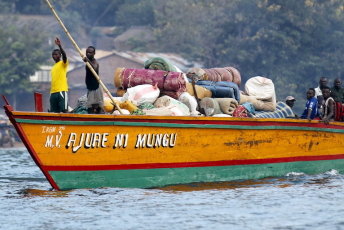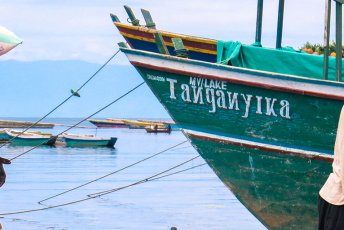The African grey parrot population in the wild is dwindling at a rate of 21% every year. Found in West and Central Africa, the bird is being targeted by the illegal wildlife trade as exotic pets, and its natural habitat is being fragmented and destroyed. Added to this the licensing policies and practices to regulate ownership are little-known, easy to ignore, and rarely implemented.
The parrot is almost extinct in Ghana, with 90-99% of its population lost to the illegal wildlife trade, and its population has decreased by over 50% in other countries where the bird is found. In the Democratic Republic of the Congo (DRC), considered the parrot’s last natural habitat, poachers catch them when they are young and are trafficking the last of them. In April this year, a Congolese trafficker was arrested in Uganda with 122 parrots and sentenced to seven years in prison.
In 2017, the Convention on the International Trade in Endangered Species of Wild Fauna and Flora (CITES) moved the African grey parrot from Appendix II to Appendix I. This means the species is threatened with extinction, and trading is prohibited except under exceptional circumstances.
Before this CITES relisting, pet keepers (those possessing fauna) in some East African countries had to register the parrot with the respective wildlife authorities. Still, this directive wasn’t enforced in most cases. However after the CITES Appendix I regulation, Kenya, Uganda and the DRC established procedures for registering parrots and offered amnesty to pet keepers who had acquired them irregularly.
In Kenya, with an annual licence to keep a parrot costing US$100 (KES12 000), some pet keepers buy trafficked parrots and don’t acquire the licence, as it’s cheaper and less bureaucratic. Many people don’t even know the licensing of parrots has been mandatory since 2017.
The focus of law enforcement agencies from East African countries has been to intercept the growing illegal trade of the parrot through virtual markets. However, the physical trading of the parrot from the DRC to other East African markets continues.
There is an active parrot trafficking network from the DRC to Kenya, with Uganda as a transit point, according to a licensed parrot keeper and a law enforcement officer, both of whom spoke to ENACT on condition of anonymity.
Poachers from communities in the DRC capture the birds by invading their nesting places in tree canopies in the forest and capturing the juveniles. Alternatively, large woven cages (kitunga) are used to capture the birds on the ground.
Due to the conflict in the Eastern DRC, some locals prefer poaching birds to working in the illegal timber, metals or minerals trades. These are controlled by armed rebels, are riskier and often result in infighting with other rebel groups or with the DRC army. A bird poacher is his own employer, works in his own time and is paid instantly in cash. Poachers sell each bird for around US$10. The healthier the bird, the higher the price because healthy birds can tolerate the long trafficking journey even in infancy.
Brokers in the DRC source the birds from poachers and transport them to their counterparts in Kampala. Transportation is through inter-country bus networks that connect major cities in the Eastern DRC, such as Goma and Bukavu, via Kigali in Rwanda, and on to Kampala, Uganda. Cargo trucks are also used. Birds are stored under the bus or truck in dark cartons with no ventilation and are often put under other luggage. The birds risk death from fumes, thirst and hunger. These long journeys involve changing bus routes, leading to extended transit periods – the fastest journey takes two days.
Brokers in Kampala are instructed by agents in Mombasa to transport the birds to Mombasa or deliver them to buyers in Kampala. While there may be many agents in Mombasa, Kenyan law enforcement agencies are aware of one particular person they believe to be the kingpin trafficker. This agent controls the entire network, says the law enforcement officer, and has avoided being identified to date.
ENACT could not establish how much the agent pays the intermediary brokers in Kampala, but he sells the parrots to pet keepers for US$100 to US$250 (KES12 000 to KES30 000) each. He doesn’t sell parrots online, working instead through a complex word-of-mouth referral system. His identity is unknown to buyers, and the police have yet to discover how his trading system works, says the licensed parrot keeper. This keeper, who lives in Nairobi and was mistakenly profiled and arrested by the police as the Mombasa agent, told ENACT he had heard about the agent but didn’t know him.
The East African criminal chain may be working with another network trafficking the birds to Gulf Cooperation Council countries, especially the United Arab Emirates and Saudi Arabia. However, this is yet to be confirmed, says the law enforcement officer.
Intercepting the trafficking of parrots through virtual markets is to be encouraged, and organisations such as the World Parrot Trust and the Global Initiative Against Transnational Organized Crime are building knowledge about this practice. But countries where this illegal wildlife trafficking occurs should also strengthen measures to prevent the often-hidden physical trafficking of parrots.
Coordination between the wildlife authorities, border officials and actors in the transport sector in Central and East Africa is essential. There is currently no dialogue between these state and non-state agencies.
In October 2021, police chiefs from the two regions and their respective ministers signed an agreement on police cooperation and criminal matters, which ENACT supported through policy advice and technical assistance. The agreement is in force pending ratification by the parliaments of the 21 member states of the two regions’ respective police chief associations – the Central African Police Chiefs Committee and the Eastern Africa Police Chiefs Cooperation Organisation.
The agreement, together with the intelligence generated by the virtual trading of the parrot, is well-positioned as a platform for state and non-state agencies to engage in addressing African grey trafficking.
An essential first step would be for the Central and East African police chief associations to present the problem to their Permanent Coordinating Committees – the highest decision-making organs of each organisation. A second step would be for these committees to include the trafficking of the parrot as part of their annual general meetings so that recommendations can be adopted.
Mohamed Daghar, Regional Coordinator, Eastern Africa, ENACT Project, ISS







